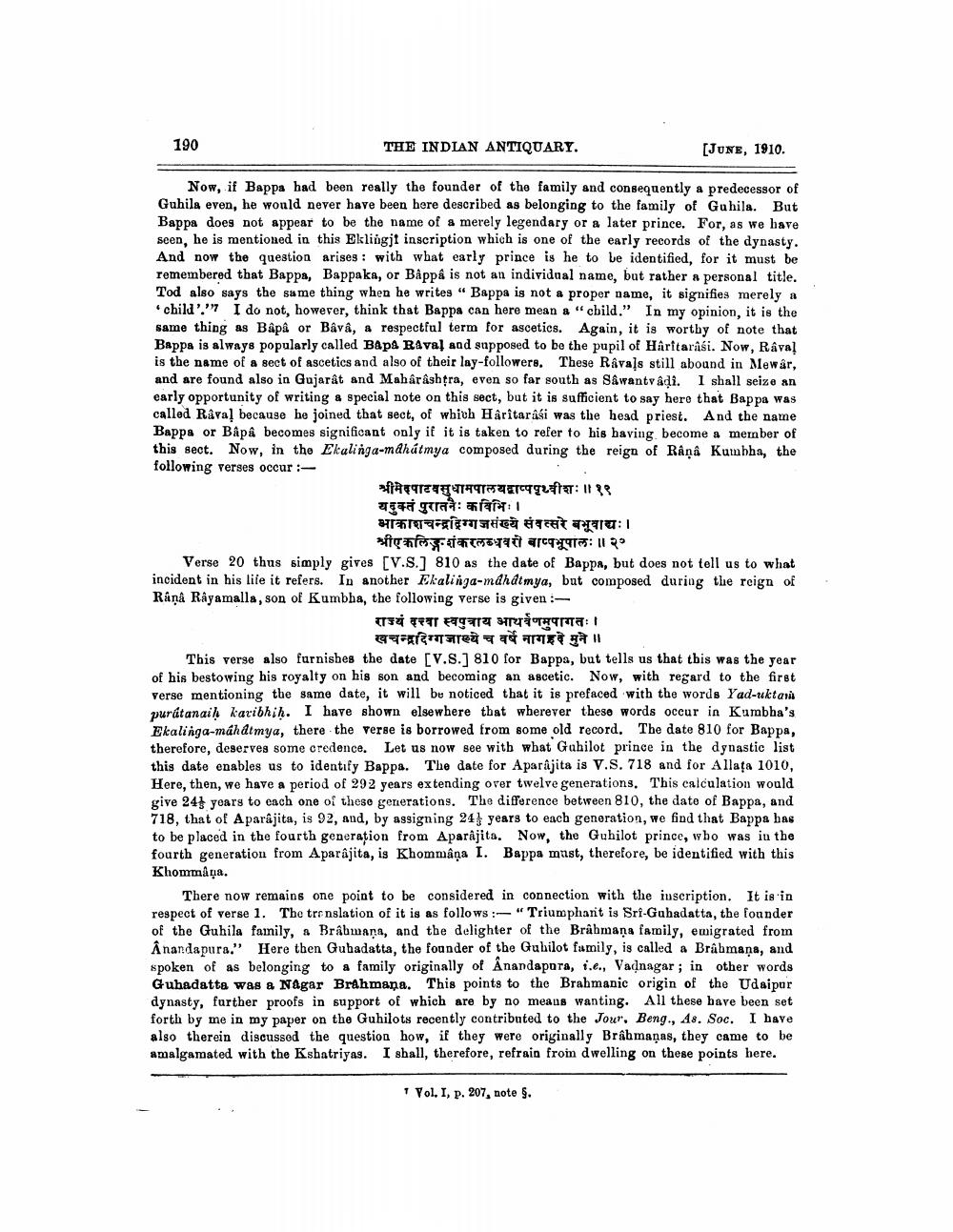________________
190
THE INDIAN ANTIQUARY.
[JUNE, 1910.
Now, if Bappa had been really the founder of the family and consequently a predecessor of Guhila even, he would never have been here described as belonging to the family of Guhila. But Bappa does not appear to be the name of a merely legendary or a later prince. For, as we have seen, he is mentioned in this Eklingji inscription which is one of the early records of the dynasty. And now the question arises : with what early prince is he to be identified, for it must be remembered that Bappa, Bappaka, or Båppa is not an individual name, but rather a personal title. Tod also says the same thing when he writes "Bappa is not a proper name, it signifies merely a
child." I do not, however, think that Bappa can here mean a "cbild." In my opinion, it is the same thing as Bápå or Bava, a respectful term for ascetics. Again, it is worthy of note that Bappa is always popularly called BAPA Raval and supposed to be the pupil of Haritarasi. Now, Raval is the name of a sect of ascetics and also of their lay-followers. These Râvals still abound in Mewar, and are found also in Gujarat and Maharashtra, even so far south as SÂwantvaļi. I shall seize an early opportunity of writing a special note on this sect, but it is sufficient to say here that Bappa was called Raval because he joined that sect, of which Hârîtarasi was the head priest. And the name Bappa or Bâpå becomes significant only if it is taken to refer to his having become a member of this sect. Now, in the Ekalinga-mahatmya composed during the reign of Rana Kumbha, the following verses occur :
श्रीमेवपाटवसुधामपालयद्वाप्पपृथ्वीशः॥ १९ ugu grad: TTI भाकाशचन्द्रदिग्गजसंख्ये संवत्सरे बभूवाद्यः।
श्रीएकलिङ्गशंकरलब्धवरो बाप्पभूपालः ।।२० Verse 20 thus simply gives [V.S.] 810 as the date of Bappa, but does not tell us to what incident in his life it refers. In another Ekalinga-mdhdtmya, but composed during the reign of Raņa Rayamalla, son of Kumbha, the following verse is given
राज्यं दत्त्वा स्वपुत्राय आथर्वणमुपागतः।
खचन्द्रदिग्गजाख्ये च वर्षे नागहवे मुने । This verse also furnishes the date [V.S.] 810 for Bappa, but tells us that tbis was the year of his bestowing his royalty on his son and becoming an ascetic. Now, with regard to the first verse mentioning the same date, it will be noticed that it is prefaced with the words Yad-uktari purátanaih karibhih. I have shown elsewhere that wherever these words occur in Kumbha's Ekalinga-mahatmya, there the verse is borrowed from some old record. The date 810 for Bappa, therefore, deserves some credence. Let us now see with what Gahilot prince in the dynastic list this date enables us to identify Bappa. The date for Aparajita is V.S. 718 and for Allața 1010, Here, then, we have a period of 292 years extending over twelve generations. This calculation would give 24years to each one of these generations. The difference between 810, the date of Bappa, and 718, that of Aparajita, is 92, and, by assigning 24 years to each generation, we find that Bappa bas to be placed in the fourth generation from Aparajita. Now, the Guhilot prince, who was in the fourth generation from Aparajita, is Khommâņa I. Bappa must, therefore, be identified with this Khommaņa.
There now remains one point to be considered in connection with the iuscription. It is in respect of verse 1. The translation of it is as follows :-"Triumphant is Sri-Gubadatta, the founder of the Guhila fainily, a Brâbmara, and the delighter of the Brahmaņa family, emigrated from Ânandapura." Here then Gubadatta, the founder of the Gubilot family, is called a Brabmaņa, and spoken of as belonging to a family originally of Anandapora, i.e., Vadnagar; in other words Guhadatta was a Nagar Brahmaņa. This points to the Brahmanic origin of the Udaipur dynasty, further proofs in support of which are by no meaus wanting. All these bave been set forth by me in my paper on the Guhilots recently contributed to the Jour. Beng., 48. Soc. I have also therein discussed the question how, if they were originally Brahmaņas, they came to be amalgamated with the Kshatriyas. I shall, therefore, refrain froin dwelling on these points here.
Pol. I, p. 207, note ş.




